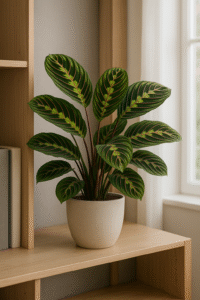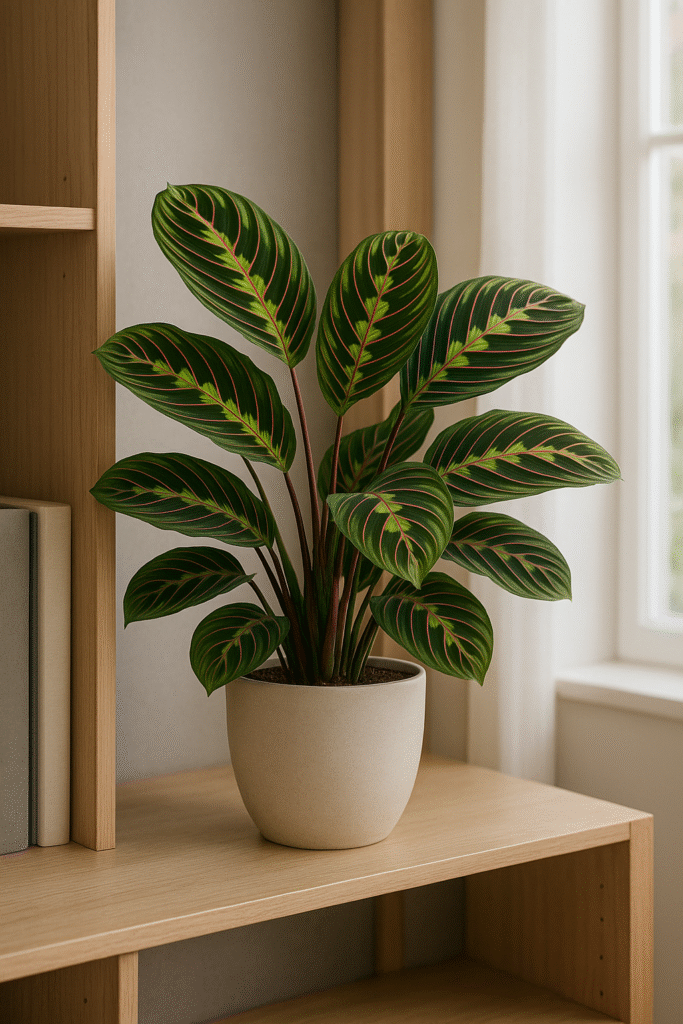The maranta (genus Maranta) is a tropical plant native to South America, especially the humid forests of Brazil. Its name honors the Italian botanist Bartolomeo Maranta, but it’s more commonly known as the prayer plant due to the fascinating way its leaves fold up at night, as if in prayer.
With lush foliage and unique leaf patterns, the maranta is one of the most sought-after ornamental plants for indoor spaces. Beyond its striking beauty, it is an easy-to-care-for plant that brings a tropical and sophisticated touch to your home decor.
Maranta Characteristics
Marantas belong to the Marantaceae family, and there are several species and cultivars, such as Maranta leuconeura — one of the most popular. Its oval-shaped leaves display intricate geometric patterns in shades of green, purple, white, and even pink, creating a true visual spectacle.
One of the most fascinating features of the maranta is its daily leaf movement, known as nyctinasty. During the day, its leaves are open and spread out; at night, they close upward, resembling hands in prayer. This natural phenomenon is an adaptation to changes in light and humidity.
Why Have a Maranta at Home?
In addition to being visually stunning, marantas offer several benefits for plant lovers:
- Air purifying: Helps improve air quality by absorbing light pollutants and releasing oxygen.
- Great for low-light spaces: Thrives in indirect light, making it ideal for living rooms, bedrooms, or offices.
- Pet-safe: Unlike many decorative plants, marantas are non-toxic to cats and dogs.
- Compact and elegant: Perfect for shelves, desks, bookcases, or as a stylish accent plant.
How to Care for a Maranta
Though low-maintenance, proper care is key to keeping your maranta healthy and vibrant:
1. Light
Marantas prefer bright, indirect light. Avoid direct sunlight, as it can burn the leaves. They adapt well to indoor spaces with filtered light. If you notice the leaf colors fading, it could be a sign of too much light exposure.
2. Watering
Marantas like consistent moisture but don’t tolerate soggy soil. Water when the top layer feels slightly dry, keeping the soil evenly moist. Use dechlorinated or filtered water if possible. In dry regions, mist the leaves regularly or use a humidifier.
3. Soil
They thrive in well-draining, light soil rich in organic matter. A good mix might include potting soil, coconut fiber, and perlite.
4. Temperature and Humidity
As tropical plants, marantas grow best in temperatures between 64°F and 79°F (18°C to 26°C). Keep them away from drafts, sudden temperature changes, or cold air. High humidity levels — above 60% — are ideal.
5. Fertilizing
During spring and summer, feed every 2 to 4 weeks with a balanced liquid fertilizer (NPK 10-10-10). Reduce or pause feeding in fall and winter.
6. Pruning and Cleaning
Remove dead or damaged leaves to encourage new growth. Light pruning helps maintain a full, attractive shape.
Common Problems and Solutions
- Curling or browning leaves: Usually caused by dry air or underwatering.
- Yellowing leaves: May indicate overwatering or poor drainage.
- Crispy leaf edges: Often a result of chlorine in tap water, low humidity, or excessive heat.
How to Propagate Maranta
The most common method of propagation is division. During repotting, gently separate the root clumps and plant them in new pots. This method helps expand your maranta collection and maintain healthy growth.
Maranta and Feng Shui
In Feng Shui, marantas are associated with balance and renewal. The leaf movement reflects flexibility and harmony, making them ideal for restful areas like bedrooms or meditation spaces. They’re believed to bring positive energy and a calming presence to your home.
Conclusion
The maranta is more than just a decorative plant: it brings life, motion, and positive energy to any space. Its exotic foliage and rhythmic leaf movements make it a favorite among indoor gardeners. With the right care, your maranta will thrive and continue to impress for years to come.


